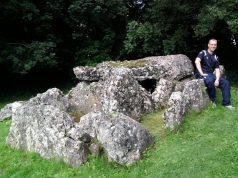

Book Review Book Review – “Again To Carthage” by John L.Parker, Jnr
ISBN: 987-1-891369-77-3
Published by Breakaway Books, New York in 2007. I couldn’t wait to get my sticky little paws on this book. Rarely, if ever, have I looked forward to a work of fiction with such naked, childish anticipation as was the case with “Again to Carthage”. For those who may not know, or perhaps even care, this book is the long anticipated sequel to what was perhaps the most famous running novel of all time, namely, “Once a Runner”. The original book, by the same author, was first published way back in 1978.
The first book has been widely recognised as a skilful blend of running ‘nerdery’, a good story line and some decent writing. Second hand copies of what those ‘in the know’ refer to as ‘OAR’, regularly change hands on the ‘net for ludicrously high prices and it has provided inspiration and entertainment for legions of runners of all standards since it was first published thirty years ago. If you ever wondered what a genuine ‘cult classic’ was, this is a great example. In that light, the first book was always going to be a hard act to follow, but, I suspect that I wasn’t on my own in hoping that Mr. Parker would be able to produce another couple of hundred pages of running-based magic.
The first instalment had introduced us to our hero, Quenton Cassidy, who was a miler at a south-eastern American college. We learned of his life, his loves and his running in engaging and convincing detail. Without giving too much away, in respect to those who may want to go back and read the original, Quenton ultimately comes out on top and disappears into the distance for a shot at the Olympic 1,500m title. The first book concludes on a sentimental but satisfactory note and in many ways there was never any need for a sequel. On starting reading ‘Again to Carthage’ there was an immediate warm fuzzy feeling about being reintroduced to some familiar characters from the previous book. It was a little like watching the season’s first episode from a favourite television series. I was anxious to hear more about what had transpired since I’d last been in touch with Quenton, Bruce Larry and the gang. As I moved through the first few chapters two things became quickly apparent. In the first instance it seemed like everyone was leading a very quiet life and secondly there was shag all running going on for them anymore.
To say that the opening chapters of this book move slowly is a massive understatement. This isn’t to say that we don’t get detail: there’s a ton of detail; but just not on topics that I could work up any interest in. We learn about Quenton’s post collegiate career, his dining preferences, his love of the outdoor life and abounding interest in all things bohemian. There are also plenty of little insider references to remind us occasionally that this is meant to be a book for runners – but the problem for me is that precious little of interest actually happens. About fifty or sixty pages in, I was starting to panic. If this didn’t improve soon, it was going to be a long way to page 344 and the end of the book. I’m genuinely sad to report that there was to be no immediate improvement. In a round about way we learned that our hero was going to take on the challenge of running a marathon and would attempt to qualify for the US Olympic team in that event. As one might have expected from this author, the running references are flawlessly dealt with when they occur, it’s just that there are not that many of them.
As the book matures, flickers of possibility begin to emerge from amongst the seemingly endless descriptions of Quenton’s day to day work and play. Whereas the early chapters seemed devoid of any discernable plotline, I slowly began to understand a little more about where the book might be heading. I felt a growing sense of relief that I wasn’t finding it quite as hard to turn each page but remained exasperated that it was clear that many of the early descriptive chapters were never going to mean much to anyone – ever – and that they certainly weren’t going to have any further bearing on the rest of the book. Once more without wanting to give away too much our hero gets to run his race and the story reaches an ultimately satisfying conclusion. The second part of the book was undoubtedly an improvement on the first.
Having turned the last page I couldn’t help but conclude that Mr. Parker should have left his original work to stand on its own merits. Perhaps he felt compelled by the cult status that his previous instalment had attained to have one more tilt at producing a classic. If that was his aim, he failed – miserably. On some levels this was an enjoyable read but the reader may well require powers of endurance on a par with the book’s hero to get the most from it.
By Mick RiceI couldn’t wait to get my sticky little paws on this book. Rarely, if ever, have I looked forward to a work of fiction with such naked, childish anticipation as was the case with “Again to Carthage”. For those who may not know, or perhaps even care, this book is the long anticipated sequel to what was perhaps the most famous running novel of all time, namely, “Once a Runner”. The original book, by the same author, was first published way back in 1978.
The first book has been widely recognised as a skilful blend of running ‘nerdery’, a good story line and some decent writing. Second hand copies of what those ‘in the know’ refer to as ‘OAR’, regularly change hands on the ‘net for ludicrously high prices and it has provided inspiration and entertainment for legions of runners of all standards since it was first published thirty years ago. If you ever wondered what a genuine ‘cult classic’ was, this is a great example. In that light, the first book was always going to be a hard act to follow, but, I suspect that I wasn’t on my own in hoping that Mr. Parker would be able to produce another couple of hundred pages of running-based magic.
The first instalment had introduced us to our hero, Quenton Cassidy, who was a miler at a south-eastern American college. We learned of his life, his loves and his running in engaging and convincing detail. Without giving too much away, in respect to those who may want to go back and read the original, Quenton ultimately comes out on top and disappears into the distance for a shot at the Olympic 1,500m title. The first book concludes on a sentimental but satisfactory note and in many ways there was never any need for a sequel. On starting reading ‘Again to Carthage’ there was an immediate warm fuzzy feeling about being reintroduced to some familiar characters from the previous book. It was a little like watching the season’s first episode from a favourite television series. I was anxious to hear more about what had transpired since I’d last been in touch with Quenton, Bruce Larry and the gang. As I moved through the first few chapters two things became quickly apparent. In the first instance it seemed like everyone was leading a very quiet life and secondly there was shag all running going on for them anymore.
To say that the opening chapters of this book move slowly is a massive understatement. This isn’t to say that we don’t get detail: there’s a ton of detail; but just not on topics that I could work up any interest in. We learn about Quenton’s post collegiate career, his dining preferences, his love of the outdoor life and abounding interest in all things bohemian. There are also plenty of little insider references to remind us occasionally that this is meant to be a book for runners – but the problem for me is that precious little of interest actually happens. About fifty or sixty pages in, I was starting to panic. If this didn’t improve soon, it was going to be a long way to page 344 and the end of the book. I’m genuinely sad to report that there was to be no immediate improvement. In a round about way we learned that our hero was going to take on the challenge of running a marathon and would attempt to qualify for the US Olympic team in that event. As one might have expected from this author, the running references are flawlessly dealt with when they occur, it’s just that there are not that many of them.
As the book matures, flickers of possibility begin to emerge from amongst the seemingly endless descriptions of Quenton’s day to day work and play. Whereas the early chapters seemed devoid of any discernable plotline, I slowly began to understand a little more about where the book might be heading. I felt a growing sense of relief that I wasn’t finding it quite as hard to turn each page but remained exasperated that it was clear that many of the early descriptive chapters were never going to mean much to anyone – ever – and that they certainly weren’t going to have any further bearing on the rest of the book. Once more without wanting to give away too much our hero gets to run his race and the story reaches an ultimately satisfying conclusion. The second part of the book was undoubtedly an improvement on the first.
Having turned the last page I couldn’t help but conclude that Mr. Parker should have left his original work to stand on its own merits. Perhaps he felt compelled by the cult status that his previous instalment had attained to have one more tilt at producing a classic. If that was his aim, he failed – miserably. On some levels this was an enjoyable read but the reader may well require powers of endurance on a par with the book’s hero to get the most from it.
By Mick Rice






